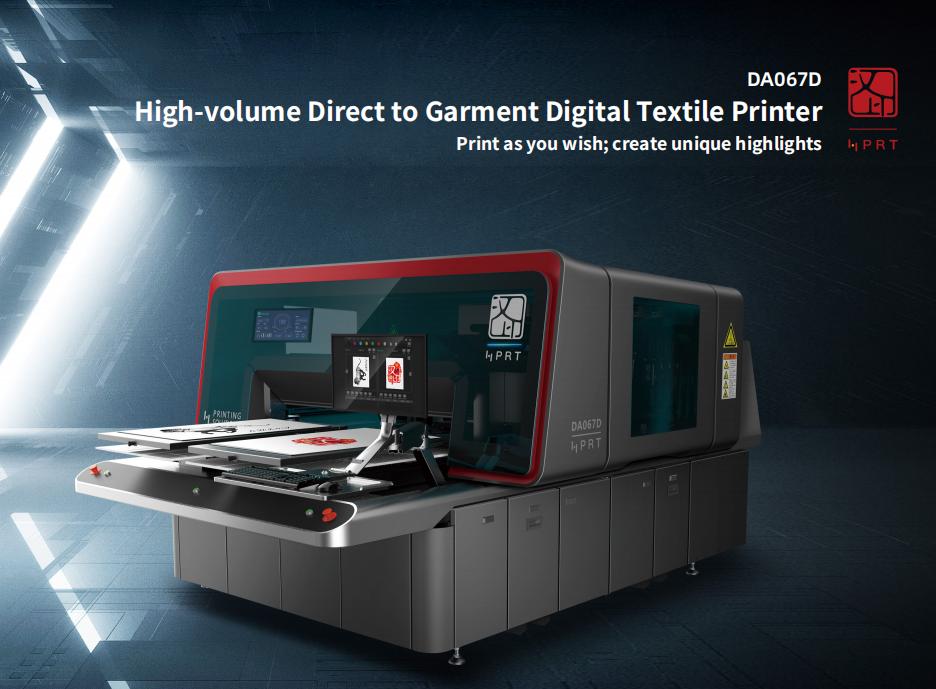Digital Fabric Printers: DTG Printing VS. DTF Printing
Printing technology has come a long way, and with the introduction of new printing techniques, we now have various options available to print designs on garments and other substrates. Two popular printing methods for apparel are Direct to Garment (DTG) printing and Direct to Film (DTF) printing. While two techniques may sound similar, they have unique features that make them stand out. In this article, we will delve into what DTG printing and DTF printing are, their processes, and the pros and cons of each.

What is DTG Printing?
DTG(Direct-to garment) printer is a type of digital fabric printer that adopts DTG printing technique. It is a process where a design is printed directly onto a garment without the use of transfer paper. To achieve this, the garment is first treated with a pre-treatment liquid that allows the ink to bond with the fabric. Next, the pre-treated garment is placed under a heat press to cure the pre-treatment and dry the fabric. The treated garment is then placed onto the DTG printer, and the design is printed onto it. Finally, the garment is placed back under the heat press to cure the ink and ensure that it binds with the fabric.
Pros of DTG Printing
One of the major advantages of DTG printing is that it allows you to print directly onto the garment without the use of transfer paper, saving time and material costs. This feature also enables you to print larger designs or oddly shaped designs that would otherwise require multiple sheets of transfer paper to print.
Another advantage of DTG printing is the durability of the design. Since the ink is bonded with the fabric fibers, the design has a smoother finish and lasts longer in the wash compared to designs that are heat transferred on.
Finally, DTG printing is fast, making it ideal for bulk printing of t-shirts or other garments.
The DTG printers offer many business opportunities for entrepreneurs and businesses interested in the custom apparel industry, such as online T-shirt stores, print-on-demand dropshipping, and custom apparel printing. If your print quantity reaches hundreds or thousands, we suggest you consider purchasing an industrial-grade DTG printer.
Cons and Considerations of DTG Printing
One of the main considerations for DTG printing is the pre-treatment process. Without the pre-treatment liquid, the design will not bind with the fabric, leading to faded and unvibrant prints. The pre-treatment process is therefore essential in the overall DTG printing process.
Another consideration is that DTG printing is limited to flat substrates such as T-shirts, hoodies, and other garments that are relatively flat. DTG printing cannot be used to decorate items like ceramic mugs or plates.
What is DTF Printing?
DTF Printing is a process where the design is printed directly onto a special film paper instead of the garment. The printed design is then coated with a special adhesive powder, melted using a heat press, and transferred onto the substrate, such as a garment or a ceramic mug. Finally, the film paper is peeled off, leaving the printed design onto the substrate.
Pros of DTF Printing
The primary advantage of DTF printing is that there is no need to pre-treat the garment or substrate with a liquid, unlike in DTG printing. This saves time and material costs.
DTF printing is also versatile, allowing designs to be transferred onto a variety of substrates, including ceramic mugs, plates, and even caps. The printing technique also enables you to stock up on pre-printed designs in bulk, making it easy to print a variety of designs quickly.
Cons and Considerations of DTF Printing
One of the main drawbacks of DTF printing is that the design is not bonded with the fabric fibers, making it less durable than DTG printing. Also, the printed design on the garment may appear thicker and less smooth than in DTG printing.
Another consideration is that DTF printing requires additional steps such as coating the printed design with a special adhesive powder, which can be messy and time-consuming.
Conclusion
Both DTG and DTF digital fabric printing methods have unique advantages and limitations. DTG printing is great for printing on flat garments quickly and in bulk, while DTF printing is versatile and can be used on a wider range of substrates. Both processes have their pros and cons, so it’s important to consider your specific needs and budget when deciding which method to use. With the right equipment and techniques, both DTG and DTF printing can produce high-quality, long-lasting prints that are sure to impress.
HPRT offers a range of industrial digital textile printers, including direct-to-garment printing machines, dye sublimation textile printing machines, and direct-to-fabric printing machines, to meet the diverse needs of the textile printing industry. Contact our experts to find the printer that’s right for you. We are also seeking global partners to help us grow our business together.








